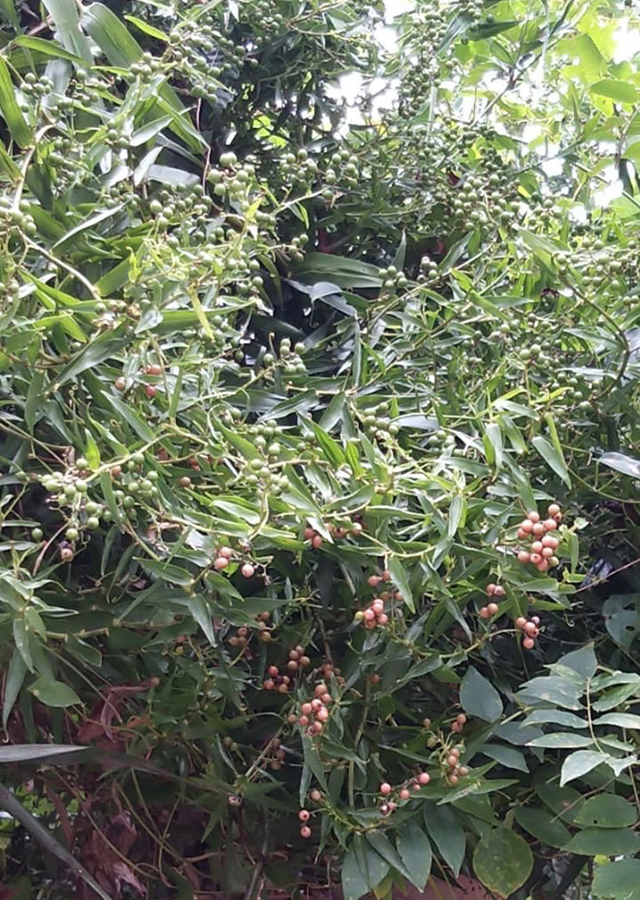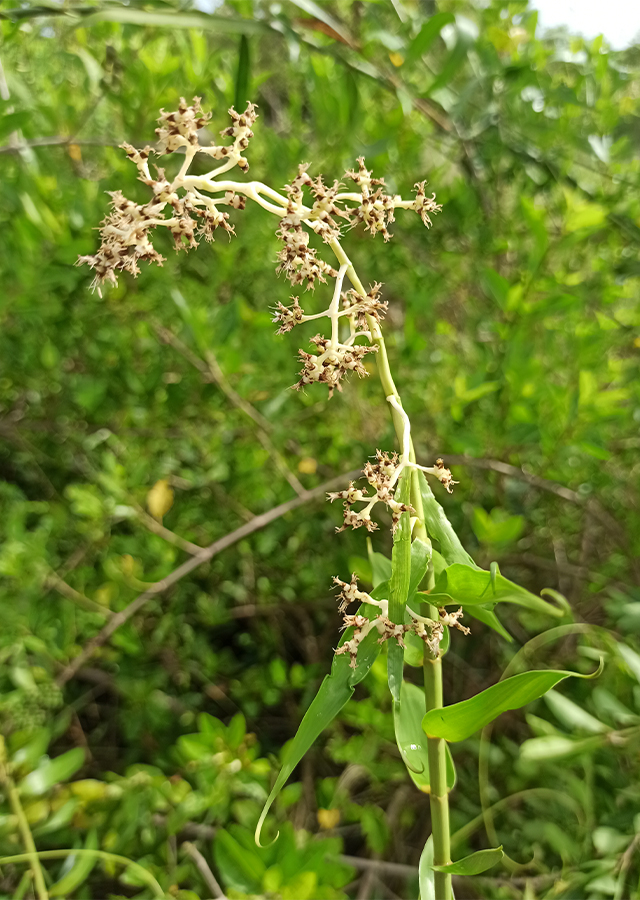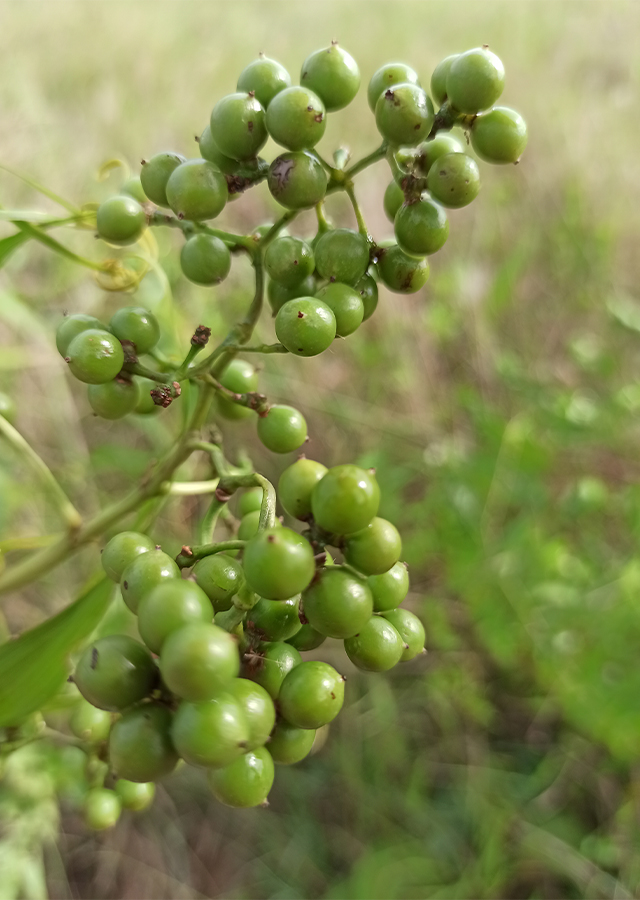False Rattan
Flagellaria indica L.
Flagellariaceae
Location in our garden
Principal



Synonym
Flagellaria angustifolia Wall.
Flagellaria catenata Lour. ex. B.A. Gomes
Flagellaria indica var. australiensis Wepfer & H.P.Linder
Habitus
Climbers. A semi woody climbing vine, climbers with hard and strong trunks or lianas that grow in clumps, perennial, with stem growing up to 15 m long and 5 m high
Part Used
Sap
The Whole Plant
Growing Requirements
Need Shade
Habitat
Wetland
Forest
Coastal
Overview
Whip vine, is native to tropical Africa, Sri Lanka, through tropical South-East Asia, Melanesia, to North Australia, and the Pacific Islands. The tough stems are used as a substitute for rattan in making basket. The trunk is strong enough often used as a substitute
rattan for weaving makes fishing nets, nets and ropes for climb. The young shoots and leaves are used in making hair-wash. The plant is also used in various medicinal applications.
Vernacular Names
False Rattan (English), Bush Cane (English), Common Flagellaria (English), Kokrok (Bahasa Indonesia), Owar (Bahasa Indonesia), Xu ye teng (Chinese), Baling-uai (Tagalog-Philippines), Qalo (Fiji), Rotan du pays (Madagascar), Guiaiti (Papua New Guinea).
Agroecology
It is found inland in edges of thickets, secondary growths, moist littoral forests, mangrove swamps, freshwater swamps from near sea level to elevations of 1,500 m. Grows naturally in peat swamps, plains low to the lower montane forest. Generally grows on canopy opening area or disturbed forest, in open area. A common forest climber which climbs over shrubs and smaller trees in wet to dry forest. It grows in open places by the sea.
Morphology
- Rhizome with 50–100 or more occasionally branching culms.
- Stems - about 1,5 - 2.5 cm thick towards the base, terete and smooth, internodes 100–250 mm long.
- Leaves - simple, single leaf, glabrous. The leaf sheath hugs the stem, the tip of the leaf curls into a branch, serves as a climber. alternate, sessile, margin entire, 15-25 cm long, variable in breadth, 2-4 cm or more, lanceolate from a rounded base and terminating in a curled tendril at the apex.
- Flowers - white, bisexual, fleshy, borne in clusters, shortly pedunculated, with irregular laxly branched panicles, appearing at the ends of the stems.White, fragrant flowers produce a lot of nectar. 15-30 cm long. Outer perianth-segments are broadly ovate or suborbicular, and the inner segments similar, more or less unequal.
- Fruits - drupe spherical, rounded, smooth, red when mature, about 6-8 mm in diameter.
- Seeds - 5-6 mm diameter, testa thick and hard. Generally one seed per fruit.
Cultivation
Propagated by seeds - removed fresh seed from the flesh.
Chemical Constituents
Flavonoids, tannins, saponins, steroids, triterpenoids, alkaloids, phytosterol, phenolic compound, kaempferol, cyanogenic glycoside.
Traditional Medicinal Uses
Medicinal Uses
- Stems and rhizomes are diuretic.
- Leaves are astringent and vulnerary, and has an antioxidant activity.
- Study showed significant potential effect and suggested a potential for the development of anti-dengue drug.
Traditional Uses
- A decoction of the leaves is drunk as a treatment for asthma, general shortness of breath and fevers. Plaster of leaves used on wounds.
- Tips of leaves applied to sore eyes. Young leaves used for making hair wash and to promote hair growth.
- Aborigines had many uses for this vine, including using the astringent leaves to heal wounds. Tips (sap) applied to sore eyes and also used as contraceptive.
Part Used
Reference Sources
- BRAIN. (2003). Flagellaria indica (FLAGELLARIACEAE); Whip vine, supplejack. http://www.brisrain.org.au/01_cms/details.asp?ID=218. 11-02-2021.
- Kew Science. (No date). Flagellaria indica L. http://www.plantsoftheworldonline.org/taxon/urn:lsid:ipni.org:names:366164-1. 11-02-2021.
- National Park of Singapore. (No date). Flagellaria indica L. https://www.nparks.gov.sg/florafaunaweb/flora/1/4/1405. 11-02-2021.
Malaysia Plant Red List. 2010. https://www.mybis.gov.my/sp/17167. 18 Oktober 2021
StuartXchange. (2016). Philippine Meicinal Plants. Baling-uai-Flagellaria indica Linn., WHIP VINE. http://www.stuartxchange.com/Baling-uai.html. 11-02-2021.
- Urban Forest. (2019). Flagellaria indica L. https://uforest.org/Species/F/Flagellaria_indica.php. 13-10-2020.
Partomihardjo T, Hermawan E, Pradana EW. 2020. Tumbuhan Hutan Rawa Gambut Merang Kepayang. Zoological Society of London (ZSL) Indonesia Programme. Editor Buchori D, Partomihardjo T, Onrizal. 1 - 314. 18 Oktober 2021
Wepfer PH, Linder HP. 2014. The taxonomy of Flagellaria (Flagellariaceae). Australian Systematic Botany, 2014(27): 159–179. 18 Oktober 2021


